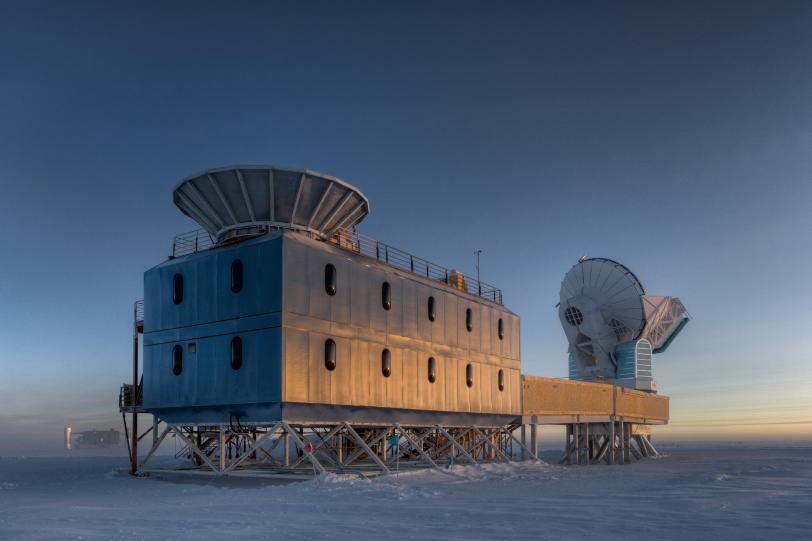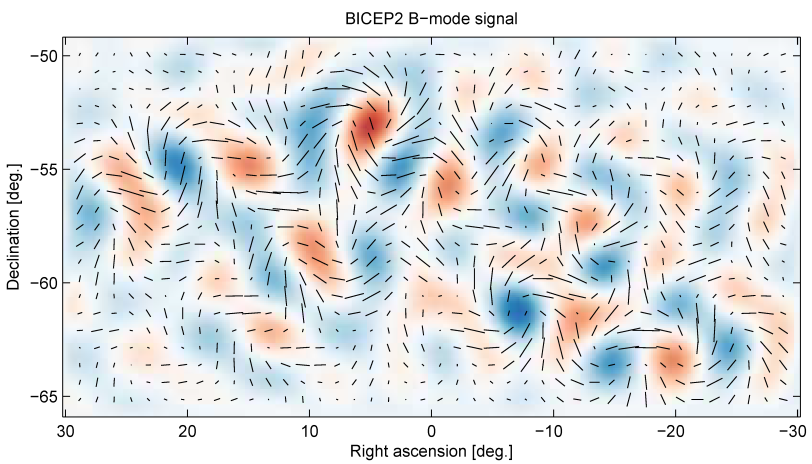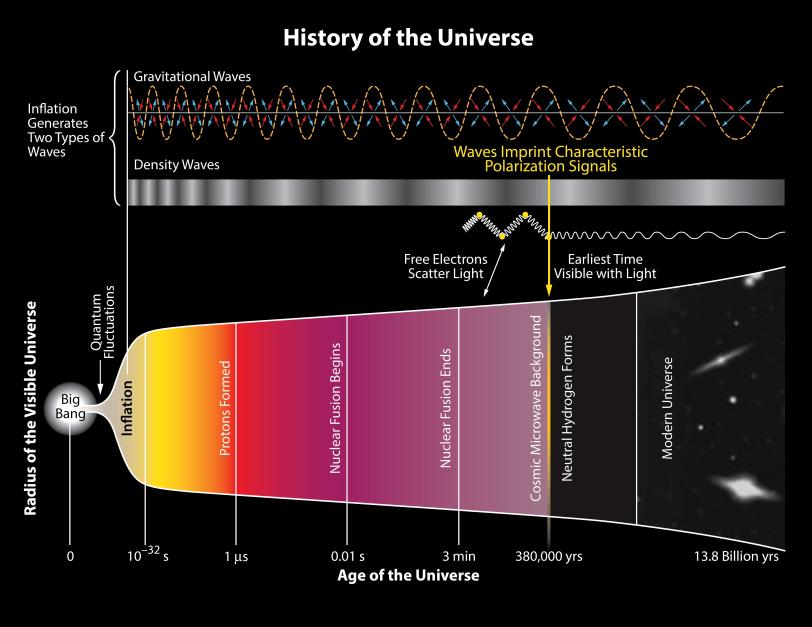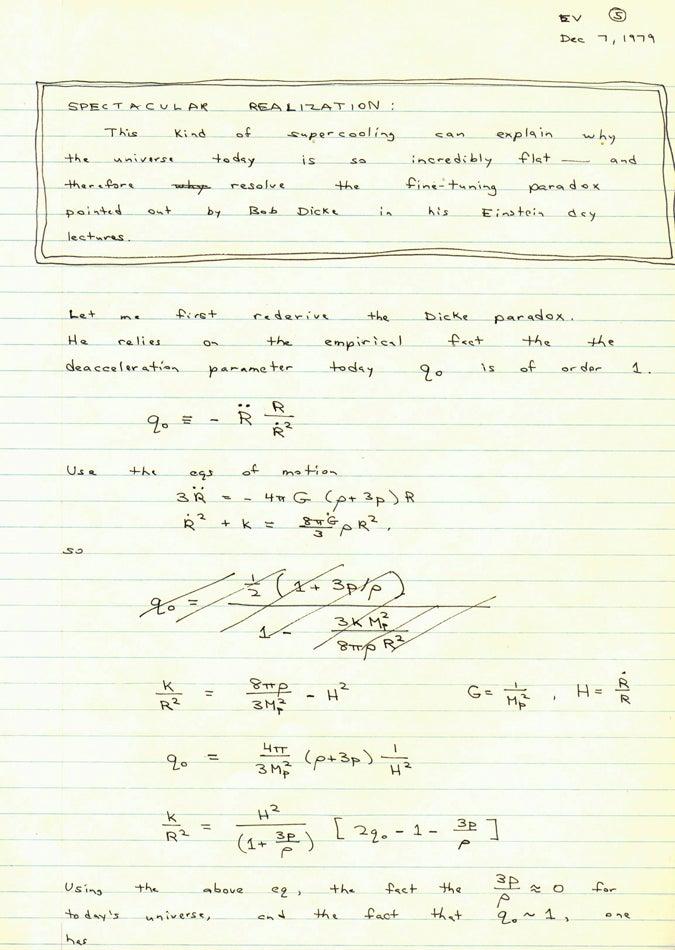Physicists Find Evidence of Cosmic Inflation
Researchers from the BICEP2 collaboration have announced the first direct evidence supporting the theory of cosmic inflation. Their data also represent the first images of gravitational waves, or ripples in space-time. These waves have been described as the "first tremors of the Big Bang."
By Bjorn Carey, Stanford News Service
Almost 14 billion years ago, the universe we inhabit burst into existence in an extraordinary event that initiated the Big Bang. In the first fleeting fraction of a second, the universe expanded exponentially, stretching far beyond the view of today's best telescopes. All this, of course, has just been theory.
Researchers from the BICEP2 collaboration today announced the first direct evidence supporting this theory, known as "cosmic inflation." Their data also represent the first images of gravitational waves, or ripples in space-time. These waves have been described as the "first tremors of the Big Bang." Finally, the data confirm a deep connection between quantum mechanics and general relativity.
"This is really exciting. We have made the first direct image of gravitational waves, or ripples in space-time across the primordial sky, and verified a theory about the creation of the whole universe," said Chao-Lin Kuo, an assistant professor of physics at Stanford University and SLAC National Accelerator Laboratory, and a co-leader of the BICEP2 collaboration.

Stanford Professor Andrei Linde celebrates physics breakthrough
These groundbreaking results came from observations by the BICEP2 telescope of the cosmic microwave background – a faint glow left over from the Big Bang. Tiny fluctuations in this afterglow provide clues to conditions in the early universe. For example, small differences in temperature across the sky show where parts of the universe were denser, eventually condensing into galaxies and galactic clusters.
Because the cosmic microwave background is a form of light, it exhibits all the properties of light, including polarization. On Earth, sunlight is scattered by the atmosphere and becomes polarized, which is why polarized sunglasses help reduce glare. In space, the cosmic microwave background was scattered by atoms and electrons and became polarized too.
"Our team hunted for a special type of polarization called 'B-modes,' which represents a twisting or 'curl' pattern in the polarized orientations of the ancient light," said BICEP2 co-leader Jamie Bock, a professor of physics at Caltech and NASA's Jet Propulsion Laboratory (JPL).
Gravitational waves squeeze space as they travel, and this squeezing produces a distinct pattern in the cosmic microwave background. Gravitational waves have a "handedness," much like light waves, and can have left- and right-handed polarizations.
"The swirly B-mode pattern is a unique signature of gravitational waves because of their handedness," Kuo said.
The team examined spatial scales on the sky spanning about 1 to 5 degrees (two to 10 times the width of the full moon). To do this, they set up an experiment at the South Pole to take advantage of its cold, dry, stable air, which allows for crisp detection of faint cosmic light.
"The South Pole is the closest you can get to space and still be on the ground," said BICEP2 co-principal investigator John Kovac, an associate professor of astronomy and physics at Harvard-Smithsonian Center for Astrophysics, who led the deployment and science operation of the project. "It's one of the driest and clearest locations on Earth, perfect for observing the faint microwaves from the Big Bang."
The researchers were surprised to detect a B-mode polarization signal considerably stronger than many cosmologists expected. The team analyzed their data for more than three years in an effort to rule out any errors. They also considered whether dust in our galaxy could produce the observed pattern, but the data suggest this is highly unlikely.
"This has been like looking for a needle in a haystack, but instead we found a crowbar," said co-leader Clem Pryke, an associate professor of physics and astronomy at the University of Minnesota.
Physicist Alan Guth formally proposed inflationary theory in 1980, when he was a postdoctoral scholar at SLAC, as a modification of conventional Big Bang theory. Instead of the universe beginning as a rapidly expanding fireball, Guth theorized that the universe inflated extremely rapidly from a tiny piece of space and became exponentially larger in a fraction of a second. This idea immediately attracted lots of attention because it could provide a unique solution to many difficult problems of the standard Big Bang theory.
However, as Guth, who is now a professor of physics at MIT, immediately realized, certain predictions in his scenario contradicted observational data. In the early 1980s, Russian physicist Andrei Linde modified the model into a concept called "new inflation" and again to "eternal chaotic inflation," both of which generated predictions that closely matched actual observations of the sky.
Linde, now a professor of physics at Stanford, could not hide his excitement about the news. "These results are a smoking gun for inflation, because alternative theories do not predict such a signal," he said. "This is something I have been hoping to see for 30 years."
BICEP2's measurements of inflationary gravitational waves are an impressive combination of theoretical reasoning and cutting-edge technology. Stanford's contribution to the discovery extends beyond Kuo, who designed the polarization detectors. Kent Irwin, a professor of physics at Stanford and SLAC, also conducted pioneering work on superconducting sensors and readout systems used in the experiment. The research also involved several researchers, including Kuo, affiliated with the Kavli Institute for Particle Astrophysics and Cosmology (KIPAC), which is supported by Stanford, SLAC and the Kavli Foundation.
BICEP2 is the second stage of a coordinated program, the BICEP and Keck Array experiments, which has a co-principal investigator structure. The four PIs are Jamie Bock (Caltech/JPL,) John Kovac (Harvard), Chao-Lin Kuo (Stanford/SLAC) and Clem Pryke (UMN). All have worked together on the present result, along with talented teams of students and scientists. Other major collaborating institutions for BICEP2 include the University of California, San Diego; University of British Columbia; National Institute of Standards and Technology; University of Toronto; Cardiff University; and Commissariat à l'Énergie Atomique.
BICEP2 is funded by the National Science Foundation (NSF). NSF also runs the South Pole Station where BICEP2 and the other telescopes used in this work are located. The Keck Foundation also contributed major funding for the construction of the team's telescopes. NASA, JPL and the Moore Foundation generously supported the development of the ultra-sensitive detector arrays that made these measurements possible.
Technical details and journal papers can be found on the BICEP2 release website: http://bicepkeck.org
This article originally appeared on the Stanford News website. Bjorn Carey is a writer at the Stanford News Service.
Contacts
Press Office Contacts:
Bjorn Carey, Stanford News Service: (650) 725-1944, bccarey@stanford.edu
Andy Freeberg, SLAC Office of Communications: (650) 926-4359, afreeberg@slac.stanford.edu
Scientist Contact:
Chao-Lin Kuo, Stanford/SLAC: (650) 704-3502, clkuo@stanford.edu









